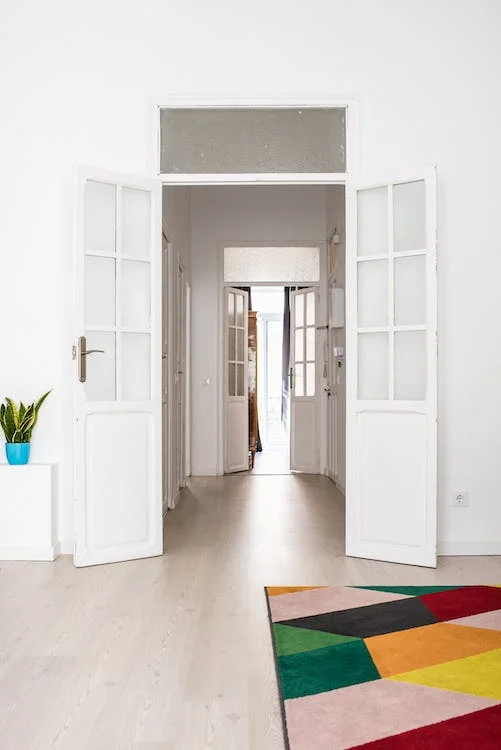Installing vinyl flooring

- Tape measure
- Pencil
- Paper
- Calculator
- Vinyl tiles
- Hammer
- Utility knife
- Leveling compound
- Putty knife
- 100-grit sandpaper
- Vinyl adhesive
1. Take measurements and order your vinyl
A measuring tape is an excellent tool for precisely determining a room’s size. You need accurate measurements or you can end up without enough vinyl to do the job. In general, it’s a good idea to order a somewhat larger quantity of vinyl than what your dimensions call for so that you don’t run out.
2. Get rid of anything that might get in the way.
Vinyl flooring can go in many different rooms, so the things you have to get rid of will depend on where you are putting it. First, take out any furniture that can stand on its own. Then, move on to the appliances. Take off the baseboards or trim along the bottom edge of the wall.
3. Get rid of the old flooring
Vinyl flooring may be installed over almost any hard, level, smooth, and dry floor surface, thus this step is especially important if you are replacing carpet with vinyl. Remove the threshold strips that line the doorways and the previous flooring. Next, you’ll want to pull out (or hammer in) any staples or nails that you come across along the subfloor that haven’t been driven below the floor’s surface.
4. Make a paper template of the floor
Make a temporary carpet by laying out long strips of thick construction paper. Remove any unnecessary curves or obstructions that were built in, and be sure to include dimensions. Use several sheets of paper to cover the ground this way. A full-scale replica of the floor can then be created by taping together the individual floor plans.
If it helps, you can measure the flooring in those hard-to-reach locations and then design or cut it out on paper.
5. Get the underlayment ready.
When a subfloor needs serious work to make it smooth, flat, or level, laying an underlayment is the simplest solution. A layer of plywood, about a quarter of an inch thick, serves as the underlayment for the vinyl.
A paper floor template should be taped to the underside of your plywood. Cut the plywood to the dimensions of your room’s flooring using this as a template. Make sure each chunk of plywood you cut fits snugly together before moving on to the next.
6. Place your under-layer.
Put your underlayer plywood sheets in the room, and leave them for 2 or 3 days. This will allow them to acclimatize to your home’s typical humidity levels, and avoid the vinyl from coming up or tearing later on in the process. Put the underlayer where it will stay, making sure the wood fits the space.
7. Put the under-layer down.
To install the underlayer, you’ll need a special stapler with 7/8-inch staples and about 16 staples per square foot of underlayer. You should never use nails or screws in the underlayer because they will make bumps in the vinyl flooring. As you move across the room, attach the underlayer to the floor with staples. Remove any staples that don’t go all the way through the plywood and replace them.
8. Finish smoothing the under-layer
Move the sander in a sweeping motion across the floor, filing down any uneven spots or overlapping edges. After that, fill the gaps and the fractures in the under-layer with the leveling compound. If you want your vinyl to go on smoothly in the end, a smooth base is essential.
9. Install vinyl flooring.
Get a notched trowel and vinyl flooring adhesive. Some adhesives can be spread with a short-napped paint roller or 1/16-inch trowel. Start in a corner and scoop glue onto the trowel. Spread this over the under-layer in one part of the room and wait for the “open” time to set. If you spread the vinyl too soon, air bubbles will form as the solvents in the glue evaporate.
If you’re using small vinyl tiles, use a kitchen rolling pin; otherwise, rent a floor roller. Roll the tile over the glue and underlayer to adhere it. Do this for each vinyl section and again when you’re done.
11. Continue to put the vinyl down.
Move across the floor, putting down the vinyl in the pattern you chose. Put some glue down, let it dry until it’s tacky, stick the vinyl to it, roll over it with your roller, and then do the same thing at the next section. Put the vinyl on the floor all the way to the edges.
Do it now if you need to cut the vinyl to fit the odd spaces along the edges. If not, put the pieces of vinyl that you cut into these spaces and roll over them to make sure they are secure.
12. Finish the flooring
Wait a few hours for the floor adhesive to dry, and then start putting back the molding/trim you took off and adding the threshold strips. If you put vinyl flooring in a bathroom, use a caulking gun to seal the seams where the floor meets the baseboards. This will keep water from ruining your vinyl and make it last longer .

